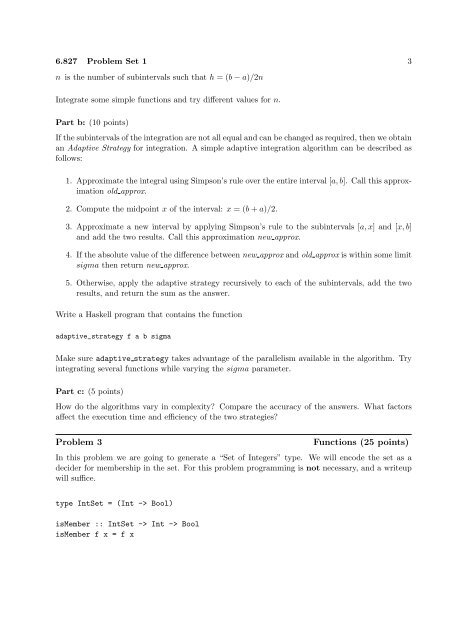Problem Set 1 - Computation Structures Group - MIT
Problem Set 1 - Computation Structures Group - MIT
Problem Set 1 - Computation Structures Group - MIT
Create successful ePaper yourself
Turn your PDF publications into a flip-book with our unique Google optimized e-Paper software.
6.827 <strong>Problem</strong> <strong>Set</strong> 1 3<br />
n is the number of subintervals such that h = (b − a)/2n<br />
Integrate some simple functions and try different values for n.<br />
Part b: (10 points)<br />
If the subintervals of the integration are not all equal and can be changed as required, then we obtain<br />
an Adaptive Strategy for integration. A simple adaptive integration algorithm can be described as<br />
follows:<br />
1. Approximate the integral using Simpson’s rule over the entire interval [a, b]. Call this approximation<br />
old approx.<br />
2. Compute the midpoint x of the interval: x = (b + a)/2.<br />
3. Approximate a new interval by applying Simpson’s rule to the subintervals [a, x] and [x, b]<br />
and add the two results. Call this approximation new approx.<br />
4. If the absolute value of the difference between new approx and old approx is within some limit<br />
sigma then return new approx.<br />
5. Otherwise, apply the adaptive strategy recursively to each of the subintervals, add the two<br />
results, and return the sum as the answer.<br />
Write a Haskell program that contains the function<br />
adaptive_strategy f a b sigma<br />
Make sure adaptive strategy takes advantage of the parallelism available in the algorithm. Try<br />
integrating several functions while varying the sigma parameter.<br />
Part c: (5 points)<br />
How do the algorithms vary in complexity? Compare the accuracy of the answers. What factors<br />
affect the execution time and efficiency of the two strategies?<br />
<strong>Problem</strong> 3 Functions (25 points)<br />
In this problem we are going to generate a “<strong>Set</strong> of Integers” type. We will encode the set as a<br />
decider for membership in the set. For this problem programming is not necessary, and a writeup<br />
will suffice.<br />
type Int<strong>Set</strong> = (Int -> Bool)<br />
isMember :: Int<strong>Set</strong> -> Int -> Bool<br />
isMember f x = f x
















